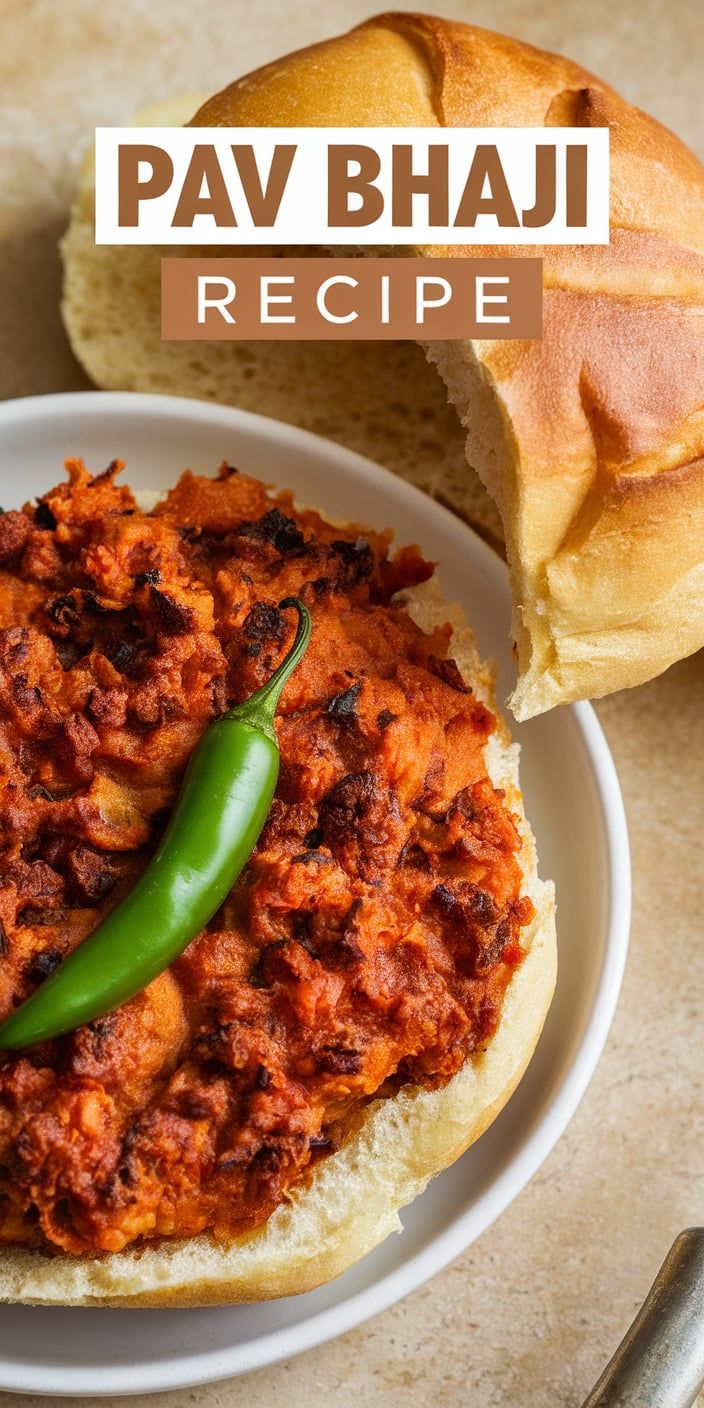Welcome to the ultimate guide to Pav Bhaji, a mouthwatering Indian street food that originated in the vibrant city of Mumbai. This incredible dish has become a global culinary sensation, capturing the hearts of food lovers everywhere with its rich flavors and incredible taste.
As a passionate food enthusiast, I’m excited to share my authentic Pav Bhaji recipe that brings the magic of Mumbai cuisine straight to your kitchen. This beloved street food is more than just a meal – it’s a celebration of spices, vegetables, and culinary creativity that transforms simple ingredients into an extraordinary dining experience.
Pav Bhaji is essentially a spicy vegetable mash served with soft butter-toasted bread rolls. It’s a perfect blend of nutritious vegetables, aromatic spices, and buttery goodness that creates an irresistible harmony of flavors. Whether you’re a seasoned cook or a curious food lover, this recipe will transport you to the bustling streets of Mumbai with every delicious bite.
Get ready to embark on a culinary journey that will tantalize your taste buds and impress your family and friends with an authentic Pav Bhaji recipe that captures the essence of Indian street food.

What is Pav Bhaji: Origin and Cultural Significance
Pav Bhaji stands as a culinary gem that captures the vibrant spirit of Mumbai street food. This iconic dish emerged from the bustling textile mills of Mumbai in the late 19th century, becoming a quick and nutritious meal for hardworking laborers. The Pav Bhaji history reveals a fascinating story of innovation and cultural adaptation.
Street vendors created this ingenious dish by mashing various vegetables together and serving it with soft bread rolls. The Mumbai street food culture quickly embraced Pav Bhaji as a delicious and affordable meal that could be prepared rapidly.
History of Mumbai’s Favorite Street Food
The origins of Pav Bhaji can be traced back to textile mill workers who needed a quick, nutritious meal during their short breaks. Vendors developed a clever solution by mixing leftover vegetables into a spicy, flavorful mash. Key developments in its evolution include:
- Late 19th-century creation in Mumbai’s textile mill areas
- Quick preparation method for busy workers
- Affordable and nutritious meal option
Why Pav Bhaji Became Popular Worldwide
Indian cuisine popularity skyrocketed with Pav Bhaji’s unique flavor profile and adaptability. The dish spread beyond Mumbai’s streets, capturing international taste buds with its rich, spicy character.
| Region | Popularity Factor |
|---|---|
| India | Original street food staple |
| United States | Exotic flavor exploration |
| United Kingdom | Cultural diversity appreciation |
Traditional Serving Methods
Traditional Pav Bhaji serving involves presenting the vegetable mash alongside buttered bread rolls. Vendors typically garnish the dish with fresh cilantro, diced onions, and a squeeze of lemon, creating a sensory experience that delights food lovers everywhere.
- Serve hot with butter-toasted bread rolls
- Garnish with fresh cilantro and onions
- Add a lemon wedge for extra zest
Essential Ingredients for Perfect Pav Bhaji Recipe
Creating an authentic Pav Bhaji starts with selecting the right Pav Bhaji ingredients. The magic of this beloved street food lies in its carefully chosen vegetables and Indian spices that transform a simple dish into a culinary masterpiece.
Vegetable Selection for Flavorful Bhaji
I recommend using a mix of fresh vegetables to create the perfect texture and taste. The core Pav Bhaji ingredients include:
- Potatoes (provides creamy base)
- Cauliflower (adds subtle sweetness)
- Green peas (brings natural sweetness)
- Carrots (enhances color and nutrition)
- Bell peppers (adds vibrant flavor)
- Tomatoes (creates tangy base)
Spice Blend Mastery
The heart of Pav Bhaji masala lies in its unique spice combination. My secret blend includes roasted and ground spices that elevate the dish’s complexity. Key Indian spices for an authentic flavor profile are:
- Cumin seeds
- Coriander powder
- Kashmiri red chili powder
- Garam masala
- Turmeric
Butter and Bread Selection
Choosing the right butter makes a significant difference. I always recommend using unsalted butter with high fat content for that rich, authentic taste. For the pav, select soft, fresh bread rolls that can be perfectly toasted with a generous spread of butter.
Kitchen Tools and Equipment Required
Preparing authentic Pav Bhaji requires specific Pav Bhaji cooking tools that make the process smooth and enjoyable. I’ll guide you through the essential Indian cooking equipment needed to create this delicious Mumbai street food at home.
- Large Flat Griddle (Tava): A must-have for perfectly cooking bhaji and toasting pavs
- Potato Masher: Critical for achieving the signature smooth vegetable texture
- Heavy-Bottom Cooking Pot: Ensures even heat distribution while preparing the vegetable mixture
- Sharp Chopping Knife: For precisely cutting vegetables
- Cutting Board: Provides a stable surface for vegetable preparation
The right Indian cooking equipment can transform your Pav Bhaji from good to restaurant-quality. I recommend investing in sturdy, high-quality tools that will serve you for multiple cooking adventures.
| Tool | Purpose | Recommended Material |
|---|---|---|
| Tava | Cooking bhaji and toasting bread | Cast Iron or Non-Stick |
| Potato Masher | Creating smooth vegetable consistency | Stainless Steel |
| Cooking Pot | Preparing vegetable mixture | Heavy-Bottom Aluminum or Stainless Steel |
Pro tip: Clean and maintain your Pav Bhaji cooking tools properly to ensure they last longer and continue delivering excellent cooking results.
Step-by-Step Pav Bhaji Recipe
Creating an authentic Pav Bhaji requires precision and passion. I’ll guide you through the Pav Bhaji recipe steps, ensuring you can master this delicious Mumbai street food right in your kitchen. Let’s break down the process into simple, manageable instructions for how to make Pav Bhaji that tastes like it’s straight from a Mumbai street cart.
Preparing the Vegetable Mash
The heart of Pav Bhaji cooking instructions starts with the vegetable base. I recommend using a mix of vegetables to create a rich, flavorful mash:
- Boil potatoes, cauliflower, carrots, and green peas until soft
- Drain the vegetables and mash them thoroughly
- Use a potato masher to create a smooth, consistent texture
Making the Signature Red Gravy
The signature red gravy gives Pav Bhaji its distinctive flavor and color. Here’s how to create the perfect base:
- Heat butter in a large pan
- Sauté finely chopped onions until golden brown
- Add ginger-garlic paste and cook for 2 minutes
- Mix in tomato puree and Pav Bhaji masala
- Blend the mashed vegetables into the gravy
Toasting the Perfect Pav
The final touch to your Pav Bhaji is perfectly toasted bread. Here’s my foolproof method:
- Slice pav bread in half
- Spread butter on both sides
- Toast on a hot griddle until golden brown
- Ensure a crispy exterior with a soft interior
Pro tip: Serve immediately with extra butter, chopped onions, and a squeeze of fresh lemon for an authentic street food experience!
Tips for Achieving Restaurant-Style Taste
Creating an authentic Pav Bhaji taste at home requires some professional cooking tips that can transform your dish from ordinary to extraordinary. I’ll share my insider secrets to help you master restaurant-style Indian food right in your own kitchen.
The key to perfect Pav Bhaji lies in several crucial techniques. Let me break down the most important Pav Bhaji cooking tips that will elevate your dish:
- Use a heavy-bottomed pan for even heat distribution and deeper flavor development
- Mash vegetables thoroughly to create a smooth, creamy consistency
- Cook the bhaji on low heat to allow spices to blend completely
- Don’t skimp on butter – it’s the secret to authentic restaurant-style flavor
Spice balance is critical for achieving that true Mumbai street food taste. I recommend using freshly ground Pav Bhaji masala and roasting the spices briefly before adding them to the vegetables. This technique helps release their full aromatic potential and creates a more complex flavor profile.
Texture plays a crucial role in authentic Pav Bhaji. The vegetables should be cooked until they’re extremely soft and can be mashed easily. I suggest using a potato masher or the back of a large spoon to create that signature smooth consistency that makes restaurant Pav Bhaji so irresistible.
The final touch that separates home cooking from restaurant-style Pav Bhaji is generous butter usage. Don’t be afraid to add an extra pat of butter when serving – it creates that rich, indulgent flavor that makes this dish so memorable.
Serving Suggestions and Accompaniments
When it comes to Pav Bhaji serving ideas, presentation is key to capturing the authentic Mumbai street food experience. I recommend garnishing your dish with freshly chopped onions, a squeeze of zesty lemon, and a generous pat of butter melting on top. These classic accompaniments elevate the flavor profile and transform your homemade Pav Bhaji into a restaurant-style masterpiece.
Indian food pairings can truly enhance your meal. I suggest serving the bhaji with crisp, buttered pav (bread rolls) that have been toasted to golden perfection. For those looking to experiment, try adding a sprinkle of fresh cilantro or a side of cooling raita to balance the spicy undertones. Street food presentation isn’t just about taste—it’s about creating a vibrant, inviting plate that delights all your senses.
To complete your culinary journey, consider pairing Pav Bhaji with refreshing beverages. A chilled nimbu pani (Indian lemonade) or a sweet lassi can perfectly complement the rich, spicy flavors. For adventurous eaters, I recommend trying fusion variations like adding a hint of cheese or serving with a tangy mint chutney to create a unique twist on this classic Mumbai street food.
Remember, the art of serving Pav Bhaji is about creating an experience that transports you straight to the bustling streets of Mumbai. With these serving suggestions, you’ll not only enjoy a delicious meal but also celebrate the vibrant culinary culture of India.
